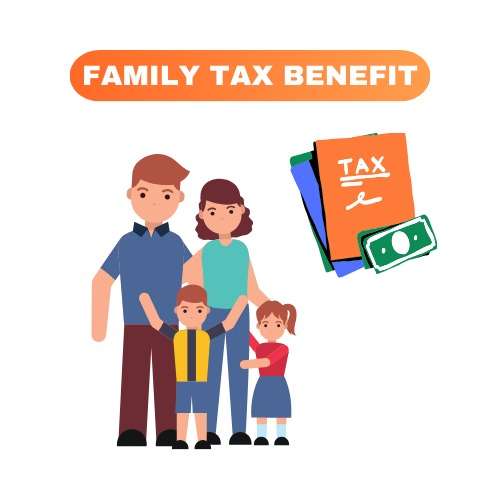“Imagine a world where raising your children comes with a financial safety net—this is where the Family Tax Benefit steps in.” As a vital part of financial planning for families, understanding and utilizing the Family Tax Benefit (FTB) can be a game-changer. The government specifically designed this support system to ease the financial burden of raising children. Whether you’re a single parent or part of a larger family unit, navigating the intricacies of the FTB can open doors to significant financial assistance. The benefit is structured into two parts, each catering to different family needs and situations.
Grasping the essence of FTB not only brings financial relief but also ensures that the foundational needs of children are adequately met. In this guide, we will delve into what the Family Tax Benefit is all about, helping families navigate and maximize this crucial support system.
What is Family Tax Benefit?

Definition and Overview
The Family Tax Benefit (FTB) is a pivotal government initiative designed to provide financial assistance to families, helping with the costs associated with raising children. It acts as a subsidy, aiming to ease the economic burdens that often come with parenthood. The benefit is generally paid directly to eligible families, contributing to daily living expenses, educational costs, and healthcare needs. This support is crucial for maintaining a healthy and sustainable family life.
Types of Family Tax Benefits
There are two main types of Family Tax Benefits: Part A and Part B. Part A is paid per child and can vary based on the family’s income, the number of children, and their ages. It’s tailored to assist with the general costs of raising children. Part B, on the other hand, provides extra help to single parents or families with a single main income. It’s particularly aimed at offering additional financial support to families where one parent may not be able to work due to caregiving responsibilities.
Eligibility for Family Tax Benefit
General Criteria
To be eligible for the Family Tax Benefit, families generally need to meet specific criteria. These include having a dependent child or children for whom you are responsible, meeting residency requirements, and having an income that falls within a certain threshold. The FTB is designed to be accessible to a wide range of families, but understanding and meeting these broad criteria is essential for receiving assistance.
Specific Requirements for Each Type
For FTB Part A, eligibility hinges on the child’s age and your family’s income. Different payment rates apply based on these factors. For FTB Part B, eligibility focuses more on the structure of the family. It’s available to single parents, grandparents caring for grandchildren, and families with a single main income where one parent stays at home to care for a young child. Each type has distinct requirements, and understanding these is crucial for a successful application.
How to Apply for Family Tax Benefit
Necessary Documentation
When applying for the Family Tax Benefit, you need to have certain documents ready. These typically include proof of identity for you and your children, income statements, and residency documentation. For new applicants, providing birth certificates or adoption papers for your children might also be necessary. Ensuring that all your documents are accurate and up-to-date is vital for a smooth application process.
Step-by-Step Application Process
The application process for the Family Tax Benefit often involves several steps:
- Gather Information: Collect all necessary documentation and information.
- Contact Authorities: Reach out to the relevant government department or use their online services.
- Fill Out Application: Complete the application form with accurate information.
- Submit Documentation: Provide all the required documents along with your application.
- Wait for Assessment: Once submitted, your application will be assessed, and you may be asked for additional information.
- Receive Decision: You’ll be notified of the outcome and, if eligible, will start receiving the benefit.
Carefully following these steps will help ensure the efficient processing of your application.
Maximizing Your Family Tax Benefit
Tips and Strategies
- Accurate Income Reporting: Always provide precise income information. Underreporting or overreporting can affect the benefit amount and lead to complications.
- Stay Updated on Policy Changes: Changes in laws or policies can impact eligibility and benefits. Keep informed to make the most of the available benefits.
- Explore Additional Supplements: Check if you’re eligible for other supplements or benefits, as these can add significant value to your FTB.
- Regularly Update Personal Information: Life changes, such as a new job or a change in family structure, can affect your benefits. Promptly update any changes in your circumstances.
- Understand the Eligibility Criteria: Fully comprehend the criteria for both Part A and Part B to ensure you’re maximizing your potential benefits.
- Utilize Government Resources: Government websites and helplines can provide guidance and help avoid misunderstandings.
Common Mistakes to Avoid
- Failing to Report Income Changes: Not reporting changes in income can lead to receiving incorrect benefit amounts and subsequent overpayment issues.
- Missing Deadlines: Failing to submit applications or renewals on time can result in missed benefits or interruptions.
- Inaccurate or Incomplete Documentation: Providing incorrect or incomplete documents can delay the process and affect your benefit.
- Ignoring Correspondence from Authorities: Ignoring letters or requests for additional information can lead to suspension or cancellation of benefits.
- Overlooking Eligibility for Other Benefits: Not exploring other available benefits can mean missing out on additional financial support.
- Not Seeking Advice When Needed: Hesitating to seek professional advice or assistance can lead to missed opportunities or errors in the application process.
Family Tax Benefit Part A
Detailed Explanation
Family Tax Benefit Part A is a payment designed to assist families with the cost of raising children. It’s typically paid per child and can vary depending on the child’s age, the family’s income, and the number of children in the family. This benefit is crucial in ensuring that children’s day-to-day needs are met, covering expenses such as food, clothing, and educational materials. It’s a flexible support system that adjusts according to changes in the family’s circumstances, including income fluctuations and the addition or reduction of dependents.
Eligibility Criteria
To be eligible for Family Tax Benefit Part A, families must meet certain criteria. These include having a dependent child or full-time secondary student aged under 20, being responsible for the child’s care, and meeting the residency and income tests. The income test assesses the family’s adjusted taxable income and determines the rate of payment. Moreover, the child must also meet immunization requirements and not be receiving a government pension or education allowance.
How It Affects Your Finances
Receiving Family Tax Benefit Part A can significantly influence a family’s financial landscape. It provides extra income that can alleviate the financial pressure of childrearing. This benefit can also impact decisions regarding work and childcare, as it offers a level of financial security. Budgeting involves allocating extra resources toward necessities, savings, or even educational and extracurricular activities for the children. It’s a financial buffer that can make a notable difference in a family’s quality of life.
Family Tax Benefit Part B
Detailed Explanation
Family Tax Benefit Part B provides additional assistance to single parents and families with one main income, particularly those with children under the age of 13. It is designed to offer extra support and alleviate the financial challenges that can come with single parenting or having one parent stay at home. The payment is made per family and varies based on the age of the youngest child, the family’s income, and the number of children.
Eligibility Criteria
Eligibility for Family Tax Benefit Part B is contingent on the family having a child under 13 years of age or a secondary student under 18 in full-time education. The applicant must be the primary caregiver and meet residency requirements. Additionally, there are income tests to determine eligibility and the rate of payment. Single parents have a higher income limit compared to couples, recognizing the unique financial challenges they face.
Benefits for Single Parents
For single parents, Family Tax Benefit Part B is particularly beneficial. It acknowledges the financial hurdles of single parenting and provides a significant boost to their income. This benefit can make it more feasible for single parents to balance work and childcare, as it offers a degree of financial stability. It can also allow for better planning and allocation of resources towards the child’s needs, reducing the stress and strain of financial management for single parents.
Conclusion
In conclusion, the Family Tax Benefit is a valuable resource for families, offering significant financial assistance. Understanding its intricacies and keeping abreast of changes is crucial for maximizing its benefits. With the right information and approach, the FTB can be a cornerstone in your family’s financial planning.
FAQs
1. Who is eligible for the Family Tax Benefit?
Eligibility depends on various factors, including income, residency, and family circumstances. Specific criteria apply to each part of the FTB.
2. How much can I receive from Family Tax Benefit Part A and Part B?
The amount varies based on your family’s income, the number of children, and their ages. You can use online calculators provided by government websites to estimate your potential benefit.
3. Can I receive a Family Tax Benefit if I’m a single parent?
Yes, single parents can qualify for both Part A and Part B, with Part B specifically providing additional support for single-parent families.
4. How does the Family Tax Benefit impact my tax return?
FTB is generally non-taxable, but it can affect your overall tax situation, especially regarding offsets and other benefits.
5. Can I still work while receiving Family Tax Benefit?
Yes, you can. However, your income from work will be considered in determining your eligibility and the amount of benefit you receive.

